English
Heybeliada - Center
- Details
- Created on 18 February 2013
- Last Updated on 11 April 2013
Village Center
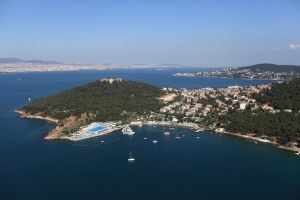 As the visitor approaches the island by ferry he can observe the Greek Orthodox seminary dominating its hill, the Halki Palas Hotel, the former Greek Commercial School (now part of the Naval High School), and the old windmill topping Değirmen Tepesi, above the Water Sports Club.
As the visitor approaches the island by ferry he can observe the Greek Orthodox seminary dominating its hill, the Halki Palas Hotel, the former Greek Commercial School (now part of the Naval High School), and the old windmill topping Değirmen Tepesi, above the Water Sports Club.
The focal point of the village is the ferry landing on the east coast, with the iskele for the sea bus a short distance to its north. The shore road betwen the two iskeles is lined with cafes and restaurants. The principal market street runs parallel to the shore road one short block in from the sea. On the southeastern promontory of the island, next to the ferry landing, is the Deniz Lisesi or Naval High School, with its twin-towered main building and miniature port, and just north of the iskeles is a little fishing port, in which fishing boats and pleasure craft are anchored.
The Greek Orthodox Church of St. Nicholas
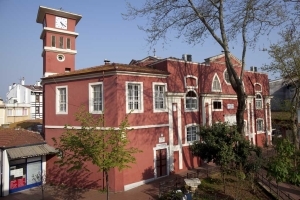 The Greek Orthodox church of St. Nicholas (Hagios Nikolaos) dominates the main square of the village, two short blocks in from the sea bus iskele. It was erected in 1857 on the ruins of a Byzantine church dedicated to St. Nicholas, the patron saint of mariners, appropriate for an island where virtually all of the men were seafarers and fishermen. The architect was Hacı Stefani Gaytanki Kalfa. The church was damaged in the 1894 earthquake, but it was soon afterwards repaired. It is cruciform in plan, with a dome on a high drum covering the central area, supported by four piers, and with barrel vaults over the four arms, a lofty clock-tower campanile rising separately from the main structure. Behind the altar is the tomb of Patriarch Samuel I, who died in 1775. A separate building in front of the narthex houses the hagiasma, or sacred spring, of St. Paraskevi (Hagia Paraskevi).
The Greek Orthodox church of St. Nicholas (Hagios Nikolaos) dominates the main square of the village, two short blocks in from the sea bus iskele. It was erected in 1857 on the ruins of a Byzantine church dedicated to St. Nicholas, the patron saint of mariners, appropriate for an island where virtually all of the men were seafarers and fishermen. The architect was Hacı Stefani Gaytanki Kalfa. The church was damaged in the 1894 earthquake, but it was soon afterwards repaired. It is cruciform in plan, with a dome on a high drum covering the central area, supported by four piers, and with barrel vaults over the four arms, a lofty clock-tower campanile rising separately from the main structure. Behind the altar is the tomb of Patriarch Samuel I, who died in 1775. A separate building in front of the narthex houses the hagiasma, or sacred spring, of St. Paraskevi (Hagia Paraskevi).
Burgazada - Center
- Details
- Created on 18 February 2013
- Last Updated on 11 April 2013
The İskele
 The iskele for the sea bus is a short distance to the north of the regular ferry landing on the northeast coast of the island. There are several cafes and restaurants on the seafront around the ferry landings. Faytons wait for hire beside the park between the two piers.
The iskele for the sea bus is a short distance to the north of the regular ferry landing on the northeast coast of the island. There are several cafes and restaurants on the seafront around the ferry landings. Faytons wait for hire beside the park between the two piers.
Beaches
Motorboats can be hired near the iskeles to take the visitor to pebble beaches on the south and west shores of the island. The Adalar Su Sporları (water sports) club, with an Olympic-size swimming pool, is on Molozburnu, the promontory just to the south of the ferry landing.
The Greek Orthodox Church of Hagios Ioannis Prodromos
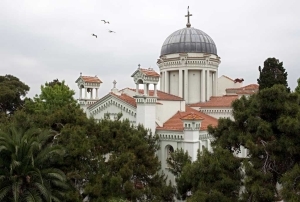 The Greek Orthodox church of Hagios Ioannis Prodromos, St. John the Baptist, is the most prominent monument in the village, its dome, raised on a high drum, dominating the view as seen from the ferry as one approaches the iskele. The church is a short way from the seafront on the first street to the south of the ferry landing.
The Greek Orthodox church of Hagios Ioannis Prodromos, St. John the Baptist, is the most prominent monument in the village, its dome, raised on a high drum, dominating the view as seen from the ferry as one approaches the iskele. The church is a short way from the seafront on the first street to the south of the ferry landing.
The present church, built in 1899, is believed to stand on the site of the katholikon of the Byzantine monastery of St. John. The original katholikon was probably built in the eleventh century, and parts of its structure are thought to be incorporated in the present church, which seems to retain the plan of the earlier structure. The evidence for this conclusion is presented by George Mastoropoulos in his Patriarchal Monasteries of the Princes’ Islands.
On the left side of the narthex, or vestibule, a stairway leads down to a small subterranean crypt with a vaulted ceiling. The crypt is dedicated to St. Methodios, for this is believed to be the dungeon in which he was imprisoned by Michael II, and where he remained for seven years before being released by the emperor Theophilos. Grosvenor describes the ordeal that Methodius endured before going to his final rest:
At Antigone, Theodora erected the Church of St. John the Baptist over the cave where the Confessor had been so long confined. In the renovated modern wooden [actually stone and brick] church, still the chief sanctuary of the islanders, little remains of the early edifice. Nevertheless the apse, or eastern portion, is part of the original structure.
Burgazada - Beyond the Center
- Details
- Created on 11 April 2013
- Last Updated on 11 April 2013
The Monastery of Hagios Georgios
 The Greek Orthodox monastery of Hagios Georgios (St. George) Karyptis is on the northern shore of the island, approached from Gönüllü Caddesi. The gateway leads to the grounds of the katholikon, from which a flight of steps leads down to the dormitory of the monastery, a two-storey stone building.
The Greek Orthodox monastery of Hagios Georgios (St. George) Karyptis is on the northern shore of the island, approached from Gönüllü Caddesi. The gateway leads to the grounds of the katholikon, from which a flight of steps leads down to the dormitory of the monastery, a two-storey stone building.
Although the monastery is believed to have been founded in the Byzantine era, the earliest reference to it is in the second half of the seventeenth century. This is when the Greek innkeepers of Istanbul decided to restore and maintain the monastery, which apparently had fallen into ruins.
The present church was built in 1897 on an endowment provided by Simeon Sinyosoğlu. It is built on the Greek-cross plan of medieval Byzantine architecture, probably repeating the design of the original katholikon. The church has a particularly fine iconostasis, carved out of wood and embossed with gold, and also an episcopal throne of finely-carved wood. On the reverse side of the icons are inscribed the words: "By thy servant Joachim, Monk from Crete, in the year of our Blessed Lord 1818." The iconostasis dates from the eighteenth century and is undoubtedly from the katholikon of the earlier monastery.
Hristos (Christ) Tepesi and the Byzantine Monastery of the Theokoryphotos
 The site of the Byzantine monastery of the Theokoryphotos, the Transfiguration of Christ, is on the summit of Hristos (Christ) Tepesi, as suggested by the name of the hill. Greek tradition, unverified by the Byzantine sources, has it that the monastery was founded by the emperor Basil I the Macedonian (r. 867-86) on the ruins of an ancient Greek temple. There is evidence of a chrysobull of the emperor Manuel I Comnenos granting the Theokoryphotos its rights as a monastery in 1158. The earliest reference to the monastery after the conquest is c. 1547 by the French scholar Petrus Gyllius, who reported that it was virtually intact.
The site of the Byzantine monastery of the Theokoryphotos, the Transfiguration of Christ, is on the summit of Hristos (Christ) Tepesi, as suggested by the name of the hill. Greek tradition, unverified by the Byzantine sources, has it that the monastery was founded by the emperor Basil I the Macedonian (r. 867-86) on the ruins of an ancient Greek temple. There is evidence of a chrysobull of the emperor Manuel I Comnenos granting the Theokoryphotos its rights as a monastery in 1158. The earliest reference to the monastery after the conquest is c. 1547 by the French scholar Petrus Gyllius, who reported that it was virtually intact.
But by the end of the eighteenth century the monastery was an abandoned ruin.
All that remains is a nineteenth-century church and a two-storey building erected in the eighteenth century, along with the ruins and architectural fragments of earlier structures scattered about the former enclosure of the monastery. Inside the entrance to the enclosure there are a number of ancient architectural fragments that include four beautifully carved Byzantine capitals.
Within the monastery precinct are four large vaulted underground cisterns which still collect rainwater even today
The view from the hilltop is superb, with all of the other islands of the archipelago in view as well as the Asian shore of the mainland opposite. Greeks and others still come to the church to mark the panigiri of the Transfiguration on August 6, which in times past would have been celebrated with music and dancing on the hilltop.
The Greek cemetery is just above the site of the monastery. The little church in the cemetery is dedicated to Hagios Profitis Ilias, the Prophet Elijah, whose chapels are always on hilltops.
Kınalıada
- Details
- Created on 18 February 2013
- Last Updated on 11 April 2013
Village Center
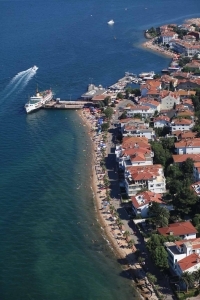 The focal point of the village, here as in the other three major isles, is the vapur iskelesi, or ferry landing, on the northeast shore. The new iskele for the sea bus is just beside the pier for the regular ferry on its south side.
The focal point of the village, here as in the other three major isles, is the vapur iskelesi, or ferry landing, on the northeast shore. The new iskele for the sea bus is just beside the pier for the regular ferry on its south side.
Kınalıada is the only one of the four larger isles that does not have faytons (horse carriages), and so those who want to explore the uninhabited western side of the island must do so on foot or by bicycle. Local residents claim to prefer the absence of horses which renders the island more sweet-smelling than its sisters. In any case, the island is so small that any destination can be reached within a few minutes’ walk.
The Greek Orthodox Church
The Greek Orthodox church is on Çınarlı Köşk Sokağı, a short way in from the shore road. The church is dedicated to the Genissa Panagia Theotokou, the Birth of the All Holy Mother of God, and was founded in 1886. The church is in the form of a three-aisled basilica with a narthex, entered from a courtyard-garden to its south. In the narthex there is a silver-clad icon depicting the Birth of the Virgin. There are other silver-clad icons on the iconostasis, or icon screen, which separates the nave from the sanctuary. The church celebrates the panigiri, or feast-day, of the Virgin’s birth on 7-8 October.
Surp Krikor Lusavoriç, Armenian Gregorian Church
 The Armenian Gregorian church is on Narçiçeğı Sokağı, on the third block in from the shore road. This was the first and only Armenian Gregorian church built on the islands. The church was founded in 1857 and is dedicated to Surp Krikor Lusavoriç, St. Gregory the Illuminator. The present church is the result of a complete reconstruction in 1988.
The Armenian Gregorian church is on Narçiçeğı Sokağı, on the third block in from the shore road. This was the first and only Armenian Gregorian church built on the islands. The church was founded in 1857 and is dedicated to Surp Krikor Lusavoriç, St. Gregory the Illuminator. The present church is the result of a complete reconstruction in 1988.
The altar curtain was taken from the Armenian church of St. Auxent in Trabzon. Behind the altar there is a painting of the Virgin and Christ Child. The altar is flanked by two paintings, the one on the left depicting St. Gregory the Illuminator, founder of the Armenian Gregorian Church, while the one on the right shows St. Nerses, patriarch of the Gregorian Armenian Church in the mid-fourth century. The side altar on the right is dedicated to St. Gregory, who is shown holding a model of the cathedral that he built at Etchmiadzin in Armenia. On the side walls of the nave there are panels containing attractive stone carvings in the medieval Armenian style. One of the panels commemorates the great Armenian composer Gomidas, who had a summer home on Kınalı during the years 1909-13.
Kınalıada Mosque
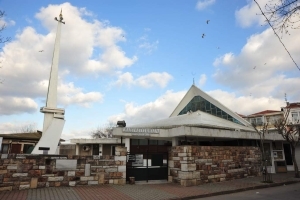 The Muslim community worships in Kınalıada Camii, which stands on the shore south of the iskele. The mosque was built in 1956 by the architect Başar Acarlı in a modern abstract style.
The Muslim community worships in Kınalıada Camii, which stands on the shore south of the iskele. The mosque was built in 1956 by the architect Başar Acarlı in a modern abstract style.
Monastery of the Transfiguration
 The present monastery of the Transfiguration is near the peak of Manastir Tepesi. This was built on the site of the Byzantine monastery of the same name, of which a number of architectural fragments have been built into the katholikon, or monastic church, while others lie scattered around the grounds. After the Turkish Conquest the monastery began to fall into ruins, but in 1722 a group of wealthy Greek merchants from Chios, who were doing business in Istanbul, financed a major restoration, building a new church on the site of the Byzantine katholikon and adding a side chapel dedicated to St. Paraskevi. The iconostasis and episcopal throne are in finely carved wood. The Byzantine icons from the original katholikon are preserved in the Greek Orthodox Patriarchate in Istanbul. The icons on the iconostasis of the present church are Russian works sent in 1723 to the patriarch Jeremias III from Tsar Peter the Great.
The present monastery of the Transfiguration is near the peak of Manastir Tepesi. This was built on the site of the Byzantine monastery of the same name, of which a number of architectural fragments have been built into the katholikon, or monastic church, while others lie scattered around the grounds. After the Turkish Conquest the monastery began to fall into ruins, but in 1722 a group of wealthy Greek merchants from Chios, who were doing business in Istanbul, financed a major restoration, building a new church on the site of the Byzantine katholikon and adding a side chapel dedicated to St. Paraskevi. The iconostasis and episcopal throne are in finely carved wood. The Byzantine icons from the original katholikon are preserved in the Greek Orthodox Patriarchate in Istanbul. The icons on the iconostasis of the present church are Russian works sent in 1723 to the patriarch Jeremias III from Tsar Peter the Great.
More Articles...
- Sedefadası - Antirovithos
- Museums, Cultural Centers
- Boat Tours
- Excursions and Tours
- Nightlife
- Beaches
- Bathing Water Analysis
- BÜYÜKADA - IN FRONT OF YÖRÜKALİ BEACH
- BÜYÜKADA - IN FRONT OF SEFEROĞLU FACILITIES
- BÜYÜKADA - IN FRONT OF WATER SPORTS CLUB
- BÜYÜKADA - IN FRONT OF NAKİBEY BEACH
- HEYBELİADA - IN FRONT OF SADIKBEY BEACH
- HEYBELİADA - IN FRONT OF WATER SPORTS CLUB
- BURGAZADA - IN FRONT OF WATER SPORTS CLUB
- KINALIADA - IN FRONT OF WATER SPORTS CLUB
- KINALIADA - IN FRONT OF ÜLKER RESTAURANT
- KINALIADA - LEFT SIDE OF PIER
- KINALIADA - RIGHT SIDE OF PIER
- İstanbul Long Term Average Precipitation
- İstanbul Long Term Average Sunshine Durations
- İstanbul Long Term Average Temperatures
- Age Distribution of the Population
- Hometown of the Islanders
- Distibution of the Population among the Islands
- Population Statistics
Subcategories
- Home
- Princes’ Islands
- History
- Practical İnformation
- Where To Stay
- Restaurants
- What To See
- What To Do
- F.A.Q
- Academic
-
Statistics
In this section you can find statistics collected from several offical resources.
Bathing water analysis / quality, sea temperatures, weather statistics, population and demographic statistics of the Pricess' Islands can be found here.
-
Bathing Water Analysis
This section is composed of bathing water snalysis results from measurements around the islands. These measurements are carried out around the four islands, in front of the 11 beaches during the summer season.
- Sea Temperatures
- Weather Reports
- Population and Demographics
-
Bathing Water Analysis


 Princes' Islands
Princes' Islands 